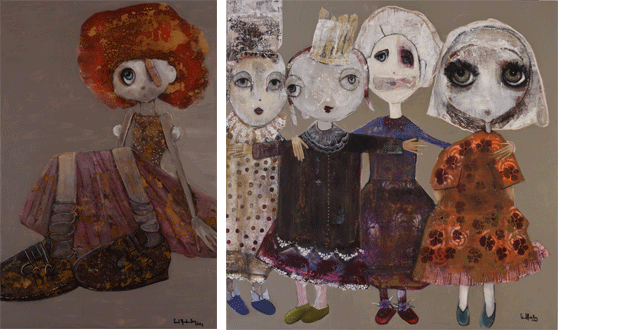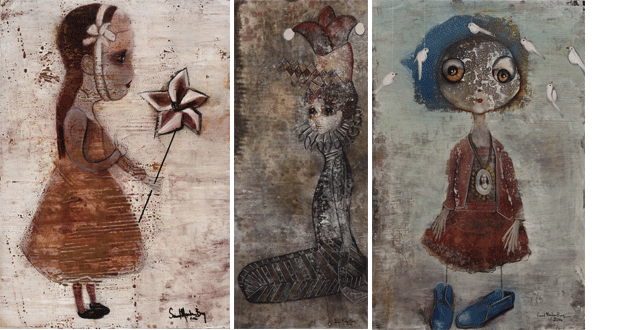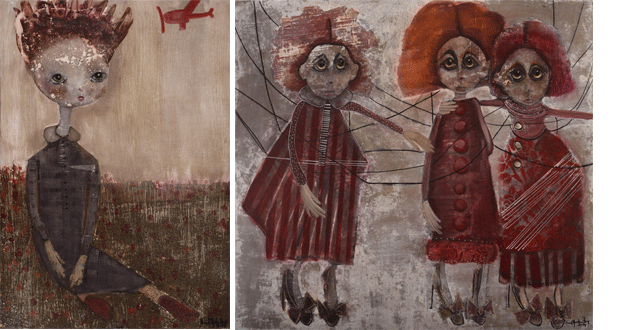Playing Without Toys: the exhibition title summarises perfectly the choice of the Syrian painter Souad Mardam Bey, who is currently exhibiting at the Zamalek Gallery.
Representing a world full of signs, emotions and colours, the display moves us deeply. Her work, though, expresses a strong desire to maintain hope in a better future.
Created in 2014, this new series of paintings is completely different from her previous works.
In 2013, she revealed huge portraits of frozen women, hidden behind dark sunglasses, so she they could "escape the uncertainty of everyday life in the Middle East."
This time, Souad Mardam Bey ponders the socio-political context that surrounded her work.
"Captivated by figurative art, the protagonists of this exhibition are not humans, but toys symbolising children victims of war," Mardam Bey explains.
The artist is inspired by the story of Pinocchio, the puppet who cries, laughs and talks like a real child.

Souad Mardam Bey. oil and mixed media on canvas (left: 130x85cm, right: 140x140cm), 2014 (Photos: courtesy of the artist)
Mardam Bey imagines and creates her own toys, however. They take the form of dolls whom she takes on adventures through 20 collage paintings.
This is a way to share with the children of war, including the Syrians, their pain, strength, nostalgia and hope to find peace.
"With the scars of war now lived, childhood is a mess! In order to cure this state of mind, I did not want my message to be direct and ghastly, like those that the media transmit daily: the distressing scenes of children tortured or afflicted," says Mardam Bey.
Dolls and clowns painted by the artist are homeless, in a state of expectation and shock; they are frozen, lost, helpless. Standing against beige, brown or black background, they give the feeling of a universe that is fluid, blurred, and filled with contrasts.
And suddenly, we see a glimmer of hope. "Eyes wide open, my character toys are hurt. However, they are not grim and their clothes are colourful. I wanted my paintings to be as beautiful as the children are," the artist — who has lived in Cairo for several years — adds.

Souad Mardam Bey. Oil and mixed media on canvas (left: 60x85cm, centre: 60x150cm, right: 130x85cm), 2014 (Photos: courtesy of the artist)
The painter reveals how she was deeply moved by an image of a dead child that circulated across the media. It was a Syrian child, wearing the shoes of his father.
"The child had not found anything else to escape the war in. Since that moment, the shoes have become my symbol of family love and protection. It has become a common theme in all my paintings," says Mardam Bey.
Indeed, in her work, we find a lot of colourful pointed large shoes, those of men, or with women's heels. Like identification signs, the pendants around the characters' necks carry photos of the family of those of the martyrs. The children's feet become increasingly thin, unstable on the ground and their hands take the form of nails.
The fate of those toy children hangs by a thread, even if the artist is trying to infuse them with some cheerful elements by multiplying red flowers, pigeons, angels and carousels.

Souad Mardam Bey. Oil and mixed media on canvas (left: 60x65cm, right: 130x120cm), 2014 (Photos: courtesy of the artist)
This article was first published in Al Ahram Hebdo
Programme:
The exhibition continues until 2 February
Zamalek Gallery, 6 Brasil Street, Zamalek, Cairo
Short link: